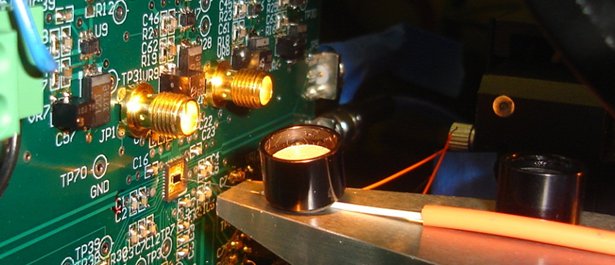NSERC announced the results of its Discovery Grant competition. This year, 2,002 of 3,482 applicants received funding. Prof. Chan Carusone’s proposal on “Energy-Efficient I/O for Supercomputing” was one of only 125 recognized with a Discovery Accelerator Supplement (DAS) in addition to a Discovery Grant. DAS awards are given to the top-ranked researchers as judged by their peers.
Research News
In collaboration with Rambus Inc., ISL researchers Dustin Dunwell and Prof. Chan Carusone have co-authored a paper appearing at this year’s VLSI Circuits Sympsoium. Titled “A 5.6Gb/s 2.4mW/Gb/s Bidirectional Link With 8ns Power-On”, the paper will be presented in Session 8 on June 15th.
Prof. Chan Carusone spoke at the Montreal Chapter of the IEEE Solid-State Circuits Society on the afternoon of June 10th on the topic of Multi-Gbps Optical Receivers with CMOS Integrated Photodetectors.
Prof. Chan Carusone is participating in the Greentouch Consortium, a university/academic consortium dedicated to creating a sustainable Internet through innovation and collaboration — increasing ICT energy efficiency by a factor of 1,000 to fundamentally transform global communications and data networks.
MaRS Innovation has announced it will be supporting efforts to commercialize the ISL’s integrated optical receiver technology.
Prof. Chan Carusone delivered a talk the Denver Chapter of the IEEE Solid-State Circuits Society on “Gbps Optical Receivers with CMOS Integrated Photodetectors”.
Prof. Chan Carusone has joined the technical program committee for the VLSI Circuits Symposium. The symposium brings together experts and experienced engineers and scientists from industry and academia around the world to discuss present and future challenges in VLSI circuits.
Prof. Chan Carusone was elected Vice-President of Regions 1-7 (North America) for the IEEE Circuits and Systems Society. The election makes him a member of the society’s Executive Committee.
Prof. Chan Carusone has joined the editorial board for the IEEE’s Journal of Solid-State Circuits – the leading research publication in the field of integrated circuits and the publication cited more often than any other in U.S. patent application than. See the announcement here.
Postdoctoral / Research Associate position
The Integrated Systems Laboratory at the University of Toronto is seeking a motivated candidate to lead the development of highly-integrated optical transceivers.
Background
| Optical communication transceivers today make use of many discrete components, each individually optimized for maximum performance above 1 Gbps, some fabricated using exotic manufacturing technologies. Specifically, the photodetector is a critical element in any optical transceiver that has evaded integration due to its limited speed when fabricated using mainstream integrated circuit manufacturing technology. Our recent research has addressed this issue by using signal processing to compensate for the intrinsically low bandwidth of integrated photodetectors. The timing of this breakthrough is serendipitous as it coincides with advances in optical fibre technology that are ushering in a new set of exciting applications for optical communication. Our objective is to incorporate the technology into a parallel transceiver capable of transmitting and receiving over multiple parallel optical fibers simultaneously at per-lane data rates exceeding 10 Gbps. |  |
The Position
A multidisciplinarian with experience in integrated circuit design is needed to:
- Most importantly, lead the design of one or more integrated circuits meeting the broad technical objectives outlined above
- Work with external agencies and suppliers to develop novel compact optoelectronic packaging solutions
- Perform full optoelectronic characterization of prototype transceivers
The position offers exciting opportunities for academic and career development in the fields of integrated circuits and optoelectronics. Although a PhD degree holder is sought, MASc-holders with relevant experience are also encouraged to apply. The position is 9-12 months in duration, and may begin immediately. Compensation will be negotiated depending upon qualifications.
Please submit CVs to contact@isl.utoronto.ca.
